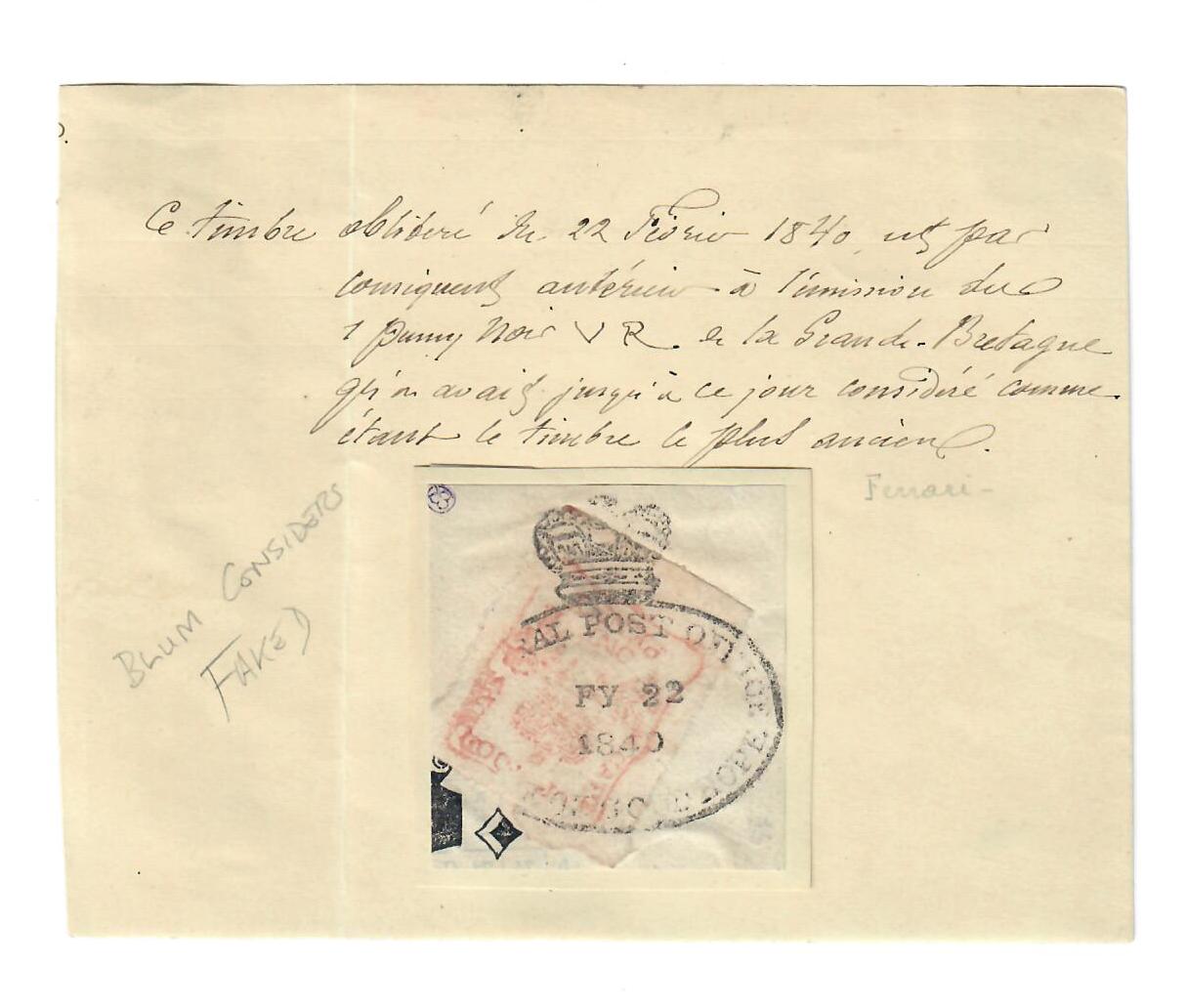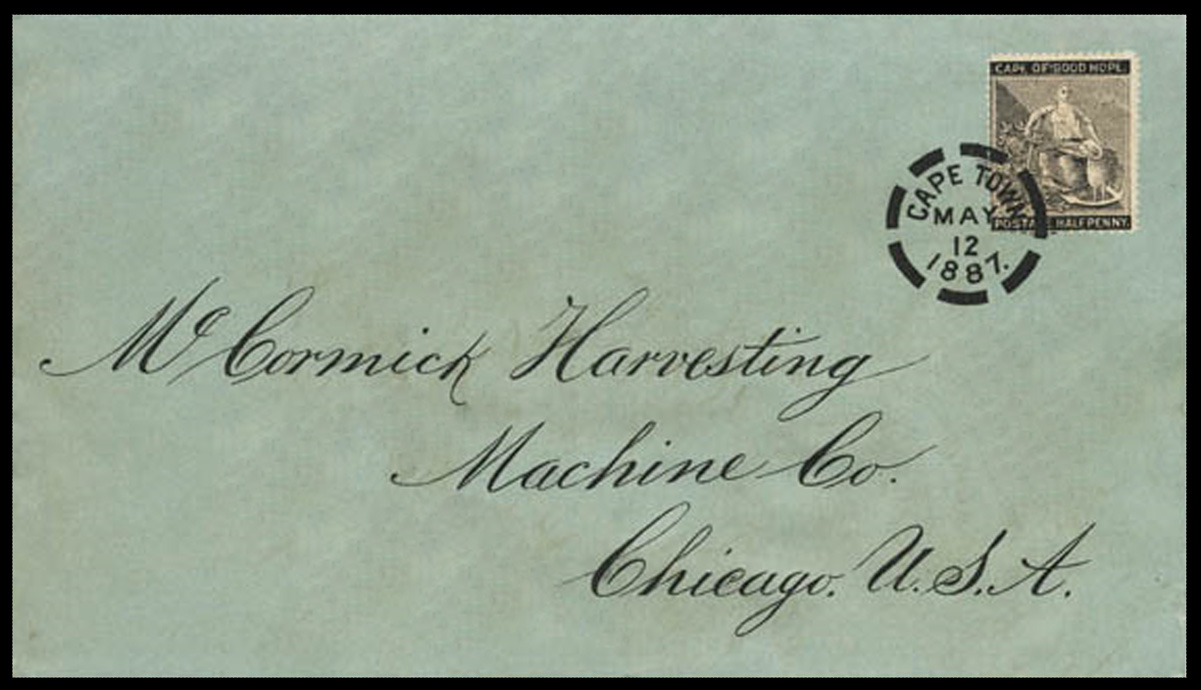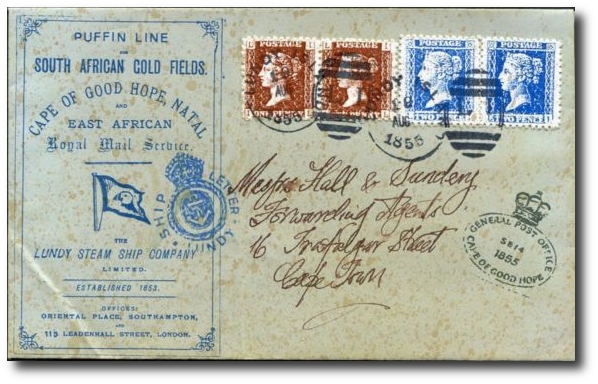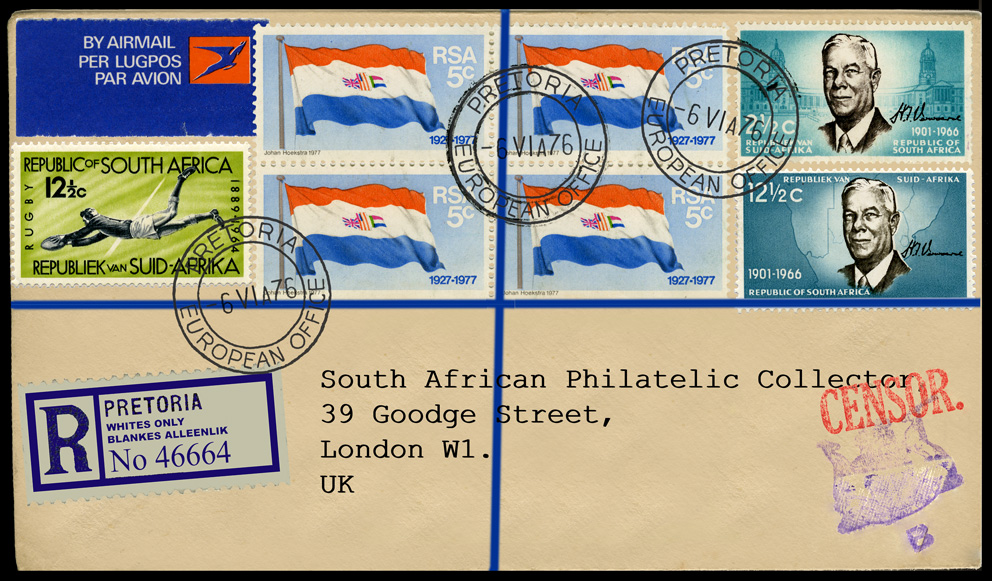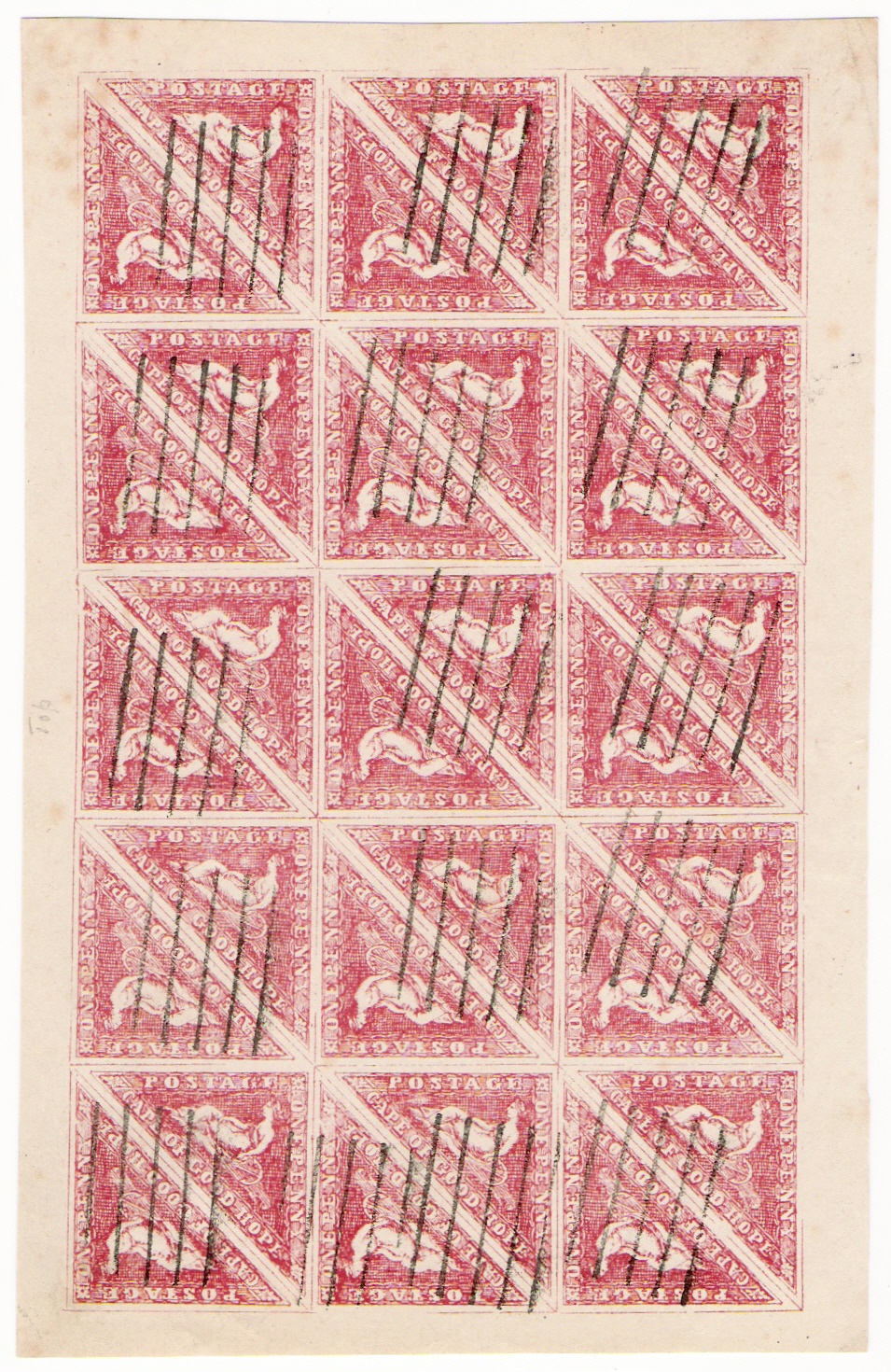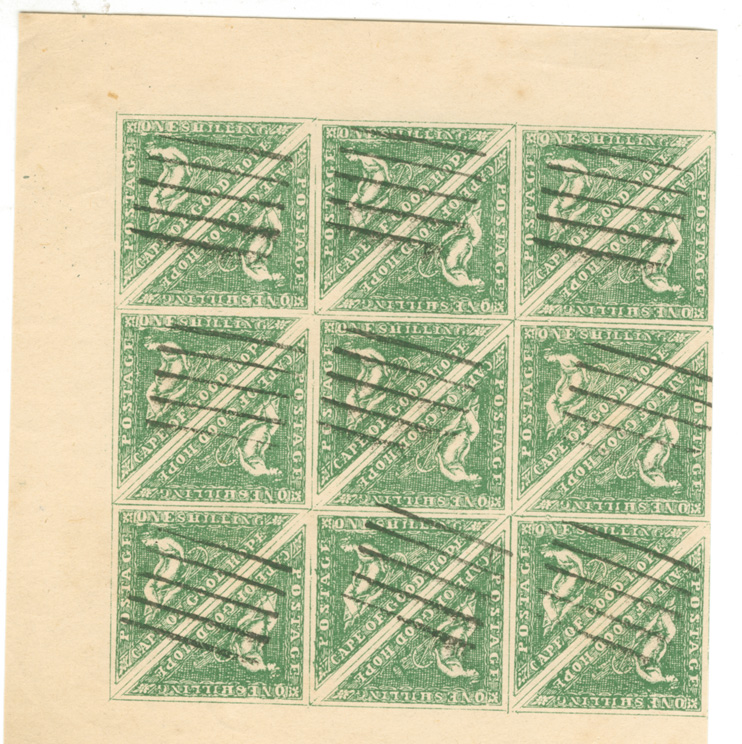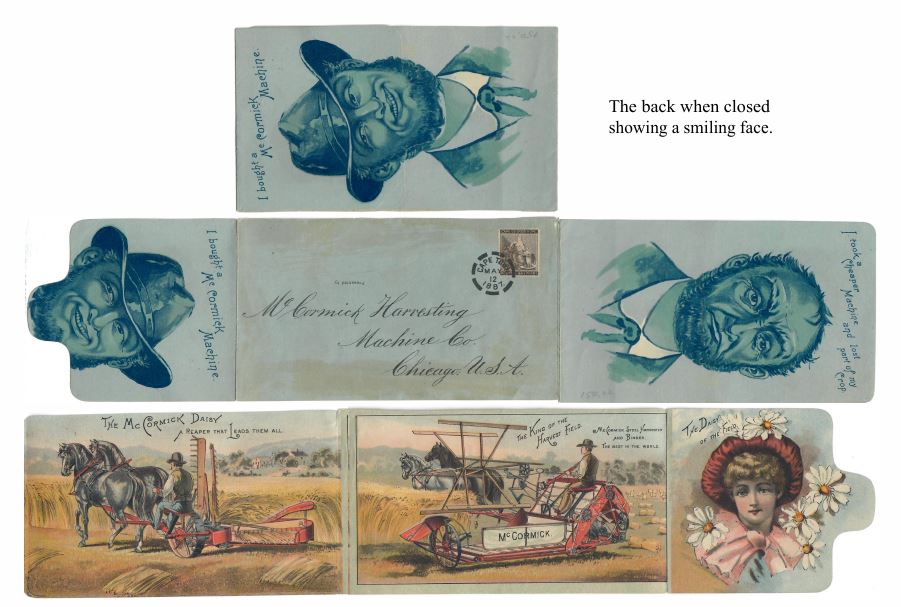Cape of Good Hope - Fabrications, forgeries and fantasies
Quote from yannisl on May 25, 2020, 7:49 pmI have opened this thread that I expect it will grow considerably in the long term, as there are so many forgeries, especially Jurgensiana. However, some items are puzzling.
I have the attached item in my collection for sometime now. I paid very little money for it. Apparently it belonged to the Ferrari collection (which I don't have a reference for). It has some notes written in French and a handwritten note "Blum Considers Faked". (which I can't read as I don't speak French).
Can anyone translate the French and provide some opinion? Have you seen anything similar?
This particular revenue stamp is found on newspapers of the period and I think is probably genuine. I am not too sure about the handstamp. You think this is an enhancement? Does anyone have anything similar?
I have opened this thread that I expect it will grow considerably in the long term, as there are so many forgeries, especially Jurgensiana. However, some items are puzzling.
I have the attached item in my collection for sometime now. I paid very little money for it. Apparently it belonged to the Ferrari collection (which I don't have a reference for). It has some notes written in French and a handwritten note "Blum Considers Faked". (which I can't read as I don't speak French).
Can anyone translate the French and provide some opinion? Have you seen anything similar?
This particular revenue stamp is found on newspapers of the period and I think is probably genuine. I am not too sure about the handstamp. You think this is an enhancement? Does anyone have anything similar?
Uploaded files:
Quote from Steve on May 26, 2020, 3:38 pmWhile I am descended on the maternal side from Huguenots, the Nels of Rouen, I do not speak any French. It surprises me that the French side of my family, my nature, is lost. Sometimes I find myself thinking in what seems to me to be French. I think it is French because I wave my hands around a lot. Sorry but arm-waving here won't help you.
I do not think that the postmark is a fake. I think it is genuine. I think that it is the tax stamp beneath it that is a fake.
Your reference to Ferrari, (spelled like the Italian racing / sports car),was most probably wrongly spelled by someone who knew only of how to spell the car ie. it is a modern reference. Ferrary, also known as "Philip Ferrari de La Renotière (January 11, 1850 – May 20, 1917)" a noted aristocratic stamp collector who assembled probably the most complete worldwide stamp collection that ever existed, or is likely to exist. (This is extracted from Wikipedia.)
The pencilled-in note that says 'Ferrari' appears to be by a different hand to "Blum considers faked". So, perhaps two people annotating this piece at different times, suggesting some degree of study over the years. Why? Because the stamp is unusually washed-out? What I am curious about are the odd black and white designs. What are they?
This sort of study is a bit highbrow for me. I do not as a rule collect fakes of this quality, nor do I collect revenues. However, I do collect forged Cape triangles which have been cancelled with fake postmarks. I will write this up and post it. Do not hold your breath in the meantime. It is an on-going project that has been on the boil for several years.
At the risk of trivialising this thread, I attach a US fake stamp and postmark on cover. These were given away at trade shows and by visiting salesmen trying to sell agricultural machinery to farmers. A clever sales gimmick. The sales pamphlet was included in this cover.
While I am descended on the maternal side from Huguenots, the Nels of Rouen, I do not speak any French. It surprises me that the French side of my family, my nature, is lost. Sometimes I find myself thinking in what seems to me to be French. I think it is French because I wave my hands around a lot. Sorry but arm-waving here won't help you.
I do not think that the postmark is a fake. I think it is genuine. I think that it is the tax stamp beneath it that is a fake.
Your reference to Ferrari, (spelled like the Italian racing / sports car),was most probably wrongly spelled by someone who knew only of how to spell the car ie. it is a modern reference. Ferrary, also known as "Philip Ferrari de La Renotière (January 11, 1850 – May 20, 1917)" a noted aristocratic stamp collector who assembled probably the most complete worldwide stamp collection that ever existed, or is likely to exist. (This is extracted from Wikipedia.)
The pencilled-in note that says 'Ferrari' appears to be by a different hand to "Blum considers faked". So, perhaps two people annotating this piece at different times, suggesting some degree of study over the years. Why? Because the stamp is unusually washed-out? What I am curious about are the odd black and white designs. What are they?
This sort of study is a bit highbrow for me. I do not as a rule collect fakes of this quality, nor do I collect revenues. However, I do collect forged Cape triangles which have been cancelled with fake postmarks. I will write this up and post it. Do not hold your breath in the meantime. It is an on-going project that has been on the boil for several years.
At the risk of trivialising this thread, I attach a US fake stamp and postmark on cover. These were given away at trade shows and by visiting salesmen trying to sell agricultural machinery to farmers. A clever sales gimmick. The sales pamphlet was included in this cover.
Uploaded files:Quote from yannisl on May 26, 2020, 8:56 pmPersonally I think that the stamp as well as the handstamp are both genuine, but the combination maybe not and I will explain my thinking.
I have a number of newspapers of the period from about 1817-1847 (about 20) which sometime back I bought them as I was interested to see if there was any reference to the Post Office, regulations etc. Most have the "tax revenue" directly stamped on the newspaper, in the same sort of pale pink washed out color. They are all poor impressions and I think the biggest problem is that they are slowly evaporating and fading away. Other newspapers such as the the Graham's Town Journal, had these either printed or sometimes on cut pieces and stuck on the newspaper (the publisher had the option to either buy stamped paper or the cut-pieces type). The design of the "tax stamp" and the color of the "fake" is a good match .
The odd black and white designs appear to be a letter and a stop either in Old English font or a Gothic font, maybe a German Newspaper or Dutch. These don't and does not fit in with whatever I have. Strange enough newspapers used to use punctuation on their title, believe it or not like the "Government Gazette.", ending with a full stop and the "Graham's Town Journal," with a comma as they had a subtitle on a second line.
The copies I have are all "Government Gazettes" and some pieces of the "Grahams Town Journal" and make a better reading that the newspapers we have today, as the Government "told it as it is" and the normal folks used the paper to advertise their merchandise, miraculous medicines, the latest invention of the pencil etc.
I don't collect revenues either or forgeries, but now and then over the years when I see something that makes me curious I buy it. Like the piece you attached, I have a modern "King" fantasy. Gerald M King calls himself a "philatelic artist" and the Cape of Good Hope piece that I attach, shows that besides being a good artist he has a good sense of humour. I also have some long forgotten "Spiro" reproductions.
Personally I think that the stamp as well as the handstamp are both genuine, but the combination maybe not and I will explain my thinking.
I have a number of newspapers of the period from about 1817-1847 (about 20) which sometime back I bought them as I was interested to see if there was any reference to the Post Office, regulations etc. Most have the "tax revenue" directly stamped on the newspaper, in the same sort of pale pink washed out color. They are all poor impressions and I think the biggest problem is that they are slowly evaporating and fading away. Other newspapers such as the the Graham's Town Journal, had these either printed or sometimes on cut pieces and stuck on the newspaper (the publisher had the option to either buy stamped paper or the cut-pieces type). The design of the "tax stamp" and the color of the "fake" is a good match .
The odd black and white designs appear to be a letter and a stop either in Old English font or a Gothic font, maybe a German Newspaper or Dutch. These don't and does not fit in with whatever I have. Strange enough newspapers used to use punctuation on their title, believe it or not like the "Government Gazette.", ending with a full stop and the "Graham's Town Journal," with a comma as they had a subtitle on a second line.
The copies I have are all "Government Gazettes" and some pieces of the "Grahams Town Journal" and make a better reading that the newspapers we have today, as the Government "told it as it is" and the normal folks used the paper to advertise their merchandise, miraculous medicines, the latest invention of the pencil etc.
I don't collect revenues either or forgeries, but now and then over the years when I see something that makes me curious I buy it. Like the piece you attached, I have a modern "King" fantasy. Gerald M King calls himself a "philatelic artist" and the Cape of Good Hope piece that I attach, shows that besides being a good artist he has a good sense of humour. I also have some long forgotten "Spiro" reproductions.
Uploaded files:
Quote from Steve on May 27, 2020, 5:42 amFascinating, both your understanding of that piece and also the Gerald King "fantasy".
I have been to Lundy. The idea that the Puffin Line could run from there to South Africa is absurd and wonderful. Its ship can barely cross the Bristol Channel. Such items are a harmless bit or fun to be enjoyed by people who know enough about the subject to find it amusing. It is intended as an 'in'" joke. (As far as I can remember, central Cape Town must be the only colonial city not to have a Trafalgar Street.) This item would not fool a serious postal historian but it might a novice. And therein lies the problem. Thanks for sharing it with us.
It begs the question, "At what point does forgery and fakery end and fantasy begin?" Or rather, "At what point does fantasy end and forgery and fakery begin?" I think that the ethics of this hinge on the intention to deceive and profit from a deception.
Below is a similar fantastic cover but one whose subject matter is much more modern. It was created to make a political point about Apartheid ie. what if Apartheid had treated everybody equally and white mail had been subject to the same racial identification as found in some black mail. Like the Lundy cover, those who know the subject will not be fooled. It includes several deliberate errors that point to it being a fake. This item exists only as a computer image and has never been sold by its author.
F
Fascinating, both your understanding of that piece and also the Gerald King "fantasy".
I have been to Lundy. The idea that the Puffin Line could run from there to South Africa is absurd and wonderful. Its ship can barely cross the Bristol Channel. Such items are a harmless bit or fun to be enjoyed by people who know enough about the subject to find it amusing. It is intended as an 'in'" joke. (As far as I can remember, central Cape Town must be the only colonial city not to have a Trafalgar Street.) This item would not fool a serious postal historian but it might a novice. And therein lies the problem. Thanks for sharing it with us.
It begs the question, "At what point does forgery and fakery end and fantasy begin?" Or rather, "At what point does fantasy end and forgery and fakery begin?" I think that the ethics of this hinge on the intention to deceive and profit from a deception.
Below is a similar fantastic cover but one whose subject matter is much more modern. It was created to make a political point about Apartheid ie. what if Apartheid had treated everybody equally and white mail had been subject to the same racial identification as found in some black mail. Like the Lundy cover, those who know the subject will not be fooled. It includes several deliberate errors that point to it being a fake. This item exists only as a computer image and has never been sold by its author.
F
Uploaded files:Quote from Bas PAYNE on May 27, 2020, 6:37 amyannisi asked for a translation of the French note about the piece which started this string. It simply says "This stamp, cancelled on 22 February 1840, is therefore earlier than the issue of the British VR 1d black which until now has been considered the earliest stamp."
yannisi asked for a translation of the French note about the piece which started this string. It simply says "This stamp, cancelled on 22 February 1840, is therefore earlier than the issue of the British VR 1d black which until now has been considered the earliest stamp."
Quote from yannisl on May 27, 2020, 10:23 amBas, thanks for the translation. The message doesn't really makes much sense unless the writer meant that the practice of cancelling stamps, either in manuscript or by a handstamp was only introduced with the penny black. Revenues on pieces predate postage stamps and might have been what inspired Rowland Hill to produce the postage stamp. Newspaper taxation was apparently one of the reasons for the American War of Independence.
Steve, I haven't been to Lundy, but her stamps fascinated me as a kid. I think forgeries are when a forger, like Speratti forged stamps with the intention to defraud the buyer, whereas Spiro's productions can be classed as 'reproductions/facsimiles' as they were sold as such. I attach a Spiro item I have. The image you attached is a classic!
Bas, thanks for the translation. The message doesn't really makes much sense unless the writer meant that the practice of cancelling stamps, either in manuscript or by a handstamp was only introduced with the penny black. Revenues on pieces predate postage stamps and might have been what inspired Rowland Hill to produce the postage stamp. Newspaper taxation was apparently one of the reasons for the American War of Independence.
Steve, I haven't been to Lundy, but her stamps fascinated me as a kid. I think forgeries are when a forger, like Speratti forged stamps with the intention to defraud the buyer, whereas Spiro's productions can be classed as 'reproductions/facsimiles' as they were sold as such. I attach a Spiro item I have. The image you attached is a classic!
Uploaded files:
Quote from Bas PAYNE on May 27, 2020, 10:55 amYannis: I was just translating what the writer said. The key question, presumably, is whether the adhesive was simply paying a tax, in which case it's a fiscal label (and not remarkably early), or whether it was paying for postage by a public carrier, in which case it would be remarkable in predating the 1d black postage stamp. Not my period or subject, but the first seems more likely. If the cancellation is genuine, it wouldn't prove that the stamp was postal - there are plenty of examples of postal cancellers being used for fiscal cancellation. Best, Bas
Yannis: I was just translating what the writer said. The key question, presumably, is whether the adhesive was simply paying a tax, in which case it's a fiscal label (and not remarkably early), or whether it was paying for postage by a public carrier, in which case it would be remarkable in predating the 1d black postage stamp. Not my period or subject, but the first seems more likely. If the cancellation is genuine, it wouldn't prove that the stamp was postal - there are plenty of examples of postal cancellers being used for fiscal cancellation. Best, Bas
Quote from yannisl on August 10, 2020, 7:16 pm@Steve
Just in passing, I cam across to https://stampauctionnetwork.com/V/v6881.cfm
showing the McCormick advertizing envelope you showed earlier and touting it as unique (Kelleher auction). As I have one and you have one and they dont' look like the above obviously is not unique. Although it appears there were a couple of variants (the images on my cover differ) from that listed in the Kelleher auction.
Can you post the "innards"? I will scan do the same a bit later.
@Steve
Just in passing, I cam across to https://stampauctionnetwork.com/V/v6881.cfm
showing the McCormick advertizing envelope you showed earlier and touting it as unique (Kelleher auction). As I have one and you have one and they dont' look like the above obviously is not unique. Although it appears there were a couple of variants (the images on my cover differ) from that listed in the Kelleher auction.
Can you post the "innards"? I will scan do the same a bit later.
Quote from Steve on August 11, 2020, 7:40 amYannis, again, it's good to have you back. Now, it's time for me to say sorry.
First, I missed your post with the Spiro sheet above. (I am guessing it is Spiro given the well-known five-line fake canceller that was one of his trademarks.) This is of great interest to me as I have a collection of Cape of Good Hope Fakes and Forgeries which I will post one of these days. I attach an example of Spiro's re-engraved forgeries bearing the same common five-line fake canceller. The fact that he had to re-engrave his printing dies indicates that he produced many, many thousands of these popular space-fillers.
Second, the McCormick advertising cover. I do not own the cover. I saw it on-line, possibly in a Kelleher auction some years ago and made a screen-grab of it. While I wanted to buy it, I did not because as a piece of Americana rather than Africana it was more expensive than I cared to pay despite it being a great and desirable example of a forged Cape rectangle on cover with wonderful fake postmark. At the time I was giving a PowerPoint display to SACS 2017. I had previously seen other PP philatelic displays made up of images taken from all over the internet. As a result, I decided to include a screen-grab of the McCormick cover as it seemed like a cost-effective way to show something relevant without the pain of buying it. I believe I cleaned the cover up in PhotoShop. I probably removed the overprint. So, bottom line, a). I cannot send you any insert and b). your's and Kelleher's cover are probably the only two known examples. I guess both are unique in their own way!
Yannis, again, it's good to have you back. Now, it's time for me to say sorry.
First, I missed your post with the Spiro sheet above. (I am guessing it is Spiro given the well-known five-line fake canceller that was one of his trademarks.) This is of great interest to me as I have a collection of Cape of Good Hope Fakes and Forgeries which I will post one of these days. I attach an example of Spiro's re-engraved forgeries bearing the same common five-line fake canceller. The fact that he had to re-engrave his printing dies indicates that he produced many, many thousands of these popular space-fillers.
Second, the McCormick advertising cover. I do not own the cover. I saw it on-line, possibly in a Kelleher auction some years ago and made a screen-grab of it. While I wanted to buy it, I did not because as a piece of Americana rather than Africana it was more expensive than I cared to pay despite it being a great and desirable example of a forged Cape rectangle on cover with wonderful fake postmark. At the time I was giving a PowerPoint display to SACS 2017. I had previously seen other PP philatelic displays made up of images taken from all over the internet. As a result, I decided to include a screen-grab of the McCormick cover as it seemed like a cost-effective way to show something relevant without the pain of buying it. I believe I cleaned the cover up in PhotoShop. I probably removed the overprint. So, bottom line, a). I cannot send you any insert and b). your's and Kelleher's cover are probably the only two known examples. I guess both are unique in their own way!
Uploaded files:
Quote from yannisl on August 11, 2020, 6:26 pm@Steve,
I am looking forward to you posting some of the forgeries from your collection. I am posting the image of the McCormick cover below. The cover I have is "three panels", whereas the Kelleher one it appears that it has four. It is an intriguing item. I don't remember when or from where I bought it to be honest.
I have been busy re-writing my collection, as well as opened a can of worms by looking at some of the stuff I have from the Union period, mostly underpaid mail and postage dues. So far on the Cape of Good Hope side, I have managed around 350 pages. I guess around another 70 items and I am done. It is amazing when you leave the collection for a while and you come back to it what you discover. So I promise to post some exciting stuff soon. Found another Davy cover also hidden in some humble CiC covers.
@Steve,
I am looking forward to you posting some of the forgeries from your collection. I am posting the image of the McCormick cover below. The cover I have is "three panels", whereas the Kelleher one it appears that it has four. It is an intriguing item. I don't remember when or from where I bought it to be honest.
I have been busy re-writing my collection, as well as opened a can of worms by looking at some of the stuff I have from the Union period, mostly underpaid mail and postage dues. So far on the Cape of Good Hope side, I have managed around 350 pages. I guess around another 70 items and I am done. It is amazing when you leave the collection for a while and you come back to it what you discover. So I promise to post some exciting stuff soon. Found another Davy cover also hidden in some humble CiC covers.
Uploaded files:

